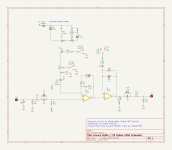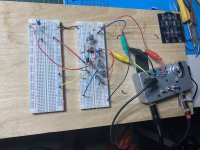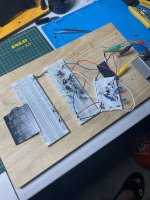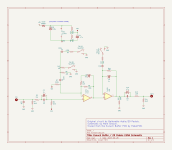Thank you! I know, but I’m on a snouse BB2 kick lately, and I feel inadequate with only 3 switches. There’s no way I can gig with it only having 3 and everyone else has 4!
It's just an input cap switch.
You are using an out of date browser. It may not display this or other websites correctly.
You should upgrade or use an alternative browser.
You should upgrade or use an alternative browser.
Missing Build Docs / Schematics
- Thread starter Robert
- Start date
marksescon
Active member
That threw me off initially as well, but according to a couple other builders (Breakfast Audio, Niche Devices), TL072 (dual op amp) runs on +17V/-17V, meaning ground, or better stated, “0V,” is half the op amp supply. If you think about the power supply as potential and absolute numbers, it makes sense.I tried it on the emulator software and that doesn't work. Maybe there's still something wrong in your schematic.
I advice to open a new thread about it. Maybe somebody can see what's this mistake, if it is there.
EDIT: I guess there's something about the bias of the op-amp. Check R1 and R5.
R5 is biasing the op amp. I’ve seen synths and studio equipment schematics that employ the same stuff as well. I also suspect R7 plays some sort of role as well but I am not sure and basing this purely on the Eunuch where R7 is connected to the bias voltage.
Furthermore, if you look at the Eunuch Buffer (https://www.pedalpcb.com/product/pcb581/), which is the Skeptical Buffer minus the elaborate bipolar voltage supply and runs on 9V/0V, R100 and R101 forms a voltage divider, equaling half the op amp power supply or 4.5V. (Eunuch can run at higher voltages, but 9V is the ‘starting’ voltage.)
I postulate that if you want the Eunuch to match the headroom of the Skeptical Buffer, you may need to run the Eunuch at
EDIT:
I have also attached a picture for what I believe is the Eunuch Buffer schematic so that you may try that in LTSpice or any other simulator. I pieced it together based purely on speculation and looking at the picture of the PCB on the product page.
Note:
- Pin 8 and 4 of IC1 are now attached to +V and ground (or 9V and 0V, respectively)
- The addition of the voltage divider network (R100, R101) and C11. The part values are numbers I pulled out of thin air, but as long as R100 and R101 are of equal resistance, the circuit should theoretically work.
- R5 and R7 are now attached to Vref (VEE, 4.5v).
Attachments
Last edited:
I understand what they are saying but the TL072IP datasheet says max 36V.That threw me off initially as well, but according to a couple other builders (Breakfast Audio, Niche Devices), TL072 (dual op amp) runs on +17V/-17V, meaning ground, or better stated, “0V,” is half the op amp supply. If you think about the power supply as potential and absolute numbers, it makes sense.
R5 is biasing the op amp. I’ve seen synths and studio equipment schematics that employ the same stuff as well. I also suspect R7 plays some sort of role as well but I am not sure and basing this purely on the Eunuch where R7 is connected to the bias voltage.
Furthermore, if you look at the Eunuch Buffer (https://www.pedalpcb.com/product/pcb581/), which is the Skeptical Buffer minus the elaborate bipolar voltage supply and runs on 9V/0V, R100 and R101 forms a voltage divider, equaling half the op amp power supply or 4.5V. (Eunuch can run at higher voltages, but 9V is the ‘starting’ voltage.)
I postulate that if you want the Eunuch to match the headroom of the Skeptical Buffer, you may need to run the Eunuch at 35V.
EDIT:
I have also attached a picture for what I believe is the Eunuch Buffer schematic so that you may try that in LTSpice or any other simulator. I pieced it together based purely on speculation and looking at the picture of the PCB on the product page.
Note:
- Pin 8 and 4 of IC1 are now attached to +V and ground (or 9V and 0V, respectively)
- The addition of the voltage divider network (R100, R101) and C11. The part values are numbers I pulled out of thin air, but as long as R100 and R101 are equal, the circuit should theoretically work.
- R5 and R7 are now attached to Vref (VEE, 4.5v).
Also if you run the Eunuch Buffer at 35V and the TL072 can only handle 17V wouldn't it fry the chip?
Can someone check me on the datasheet to make sure I am reading it correctly.
marksescon
Active member
I understand what they are saying but the TL072IP datasheet says max 36V.
Also if you run the Eunuch Buffer at 35V and the TL072 can only handle 17V wouldn't it fry the chip?
You are right, as the Eunuch product page denotes a range from 9V to 30V. I will correct my original post. Running Eunuch at higher voltages to match the headroom of the Skeptical is a wild proposal that I haven’t substantiated. I am not entirely sure it’s true, just a suggestion I based on people turning synth modules into guitar pedals.
benny_profane
Well-known member
Vsupply is the max operating potential.understand what they are saying but the TL072IP datasheet says max 36V.
Also if you run the Eunuch Buffer at 35V and the TL072 can only handle 17V wouldn't it fry the chip?
Vs=(V+)-(V-)
TL07X devices have a Vs_max of 42V. The 36V spec refers to the max on the input pins (i.e., common mode voltage and voltage differential), not the supply absolute.
EDIT: The 36V spec only applies to M-suffix (military), NS, and PS packages; all others are -0.5–0.5V.
Last edited:
Thanks for the updated schematic Robert!!
It's just an input cap switch.
So the extra input cap switch is part of the boost circuit only???
I think I understand now. If pin 4 Vcc neg is connected to ground in the circuit, the input pins can handle the 36V.Vsupply is the max operating potential.
Vs=(V+)-(V-)
TL07X devices have a Vs_max of 42V. The 36V spec refers to the max on the input pins (i.e., common mode voltage and voltage differential), not the supply absolute.
Because Vs = 36 -(-0) = 36V
Is this on the right track?
benny_profane
Well-known member
Pins 8 and 4 are your positive and negative supply pins. The Vs measurement is the absolute sum of the difference. The input pin max deals with the common-mode voltage or differential voltage measurement. These are essentially measurements of the difference in voltage seen at the positive and negative inputs. In most circuits we’re dealing with (i.e., voltage followers and inverting and non-inverting amplifiers) this is not really a design concern since the two pins are typically equal.
NOTE: I need to correct my previous post. I thought something looked odd, so I went back to the datasheet. The 36V figure is for M-suffix (military), NS, and PS packages. Typically the differential figure is around -0.5–0.5V (which is the spec for the standard TL072).
NOTE: I need to correct my previous post. I thought something looked odd, so I went back to the datasheet. The 36V figure is for M-suffix (military), NS, and PS packages. Typically the differential figure is around -0.5–0.5V (which is the spec for the standard TL072).
marksescon
Active member
I breadboarded the two schematics (Skeptical Buffer and my best guess at the Eunuch Buffer) and soldered up the Skeptical Buffer - and all circuits worked. The breadboarded Skeptical Buffer sounded similar to the PedalPCB board and the Eunuch sounded like the Skeptical Buffer with less headroom (as anticipated). Note: My bigger protoboards are of poor quality and can measure as much as 100 ohms of resistance across various holes! - which may affect my final products.
Granted, my observations of sound quality are merely subjective, I wish I had an oscilloscope to objectively confirm my schematics and the circuits, and I’ve only played the actual EUNA once. But I am confident that the schematics I drew up are mostly correct.
Below I’ve reposted the schematics (Skeptical and, once again, my best guess at the Eunuch) as well as my respective breadboards that are quite literally mounted on breadboards.
Granted, my observations of sound quality are merely subjective, I wish I had an oscilloscope to objectively confirm my schematics and the circuits, and I’ve only played the actual EUNA once. But I am confident that the schematics I drew up are mostly correct.
Below I’ve reposted the schematics (Skeptical and, once again, my best guess at the Eunuch) as well as my respective breadboards that are quite literally mounted on breadboards.
Attachments
Last edited:
Robert
Reverse Engineer
So the extra input cap switch is part of the boost circuit only???
Yep, that's correct.
BlackBox Overdrive 2 Stage Pro Mod Quick Start Guide
Fama
Well-known member
Man the normal Pot and Kettle is so easy to understand - boost, clip, smooth. The tight switch is not bad either, as long as you know it only works with boost enabled.
Why complicate things with "Circuit mode switch" or "Drive mode switch" I don't understand. One enables the boost, one controls the clipping. Very simple.
I would also object to it having enough volume to "break my neighbors windows", although throwing the thing would probably do the trick.
jesuscrisp
Well-known member
No but it certainly LOOKS incorrect I'm afraid. What sort of frequency response are you getting from the simulations?Can anyone verify the Euna schematic as correct?
marksescon
Active member
Can anyone verify the Euna schematic as correct?
I shared the schematic on Reddit and on my social media, and a few other users confirmed that the schematic is correct and matches the (Skeptical Buffer) PCB.
No but it certainly LOOKS incorrect I'm afraid. What sort of frequency response are you getting from the simulations?
I think the confusion arises because people are negating that the op amp is being supplied +17V/-17V, so they believe the op amp isn’t being biased correctly.
Admittedly I too thought the schematic looked wonky especially the power supply but the voltages check out:


Plus, the supply looks similar to that in the DODFX10.
I have breadboarded the schematic and soldered up the board and felt they sounded the same. But I don’t own an oscilloscope to confirm that they do in fact “sound” the same. Although, I think my SPDT diagrams may be backward, and ground should go to pin 3 (rather than 1).
I’m kind of curious why no one has attempted to trace the Skeptical Buffer PCB itself given it has so few components. When someone else double-checked my schematic against the Skeptical Buffer PCB, it only took them 30 minutes with a multimeter. (For example, I had C6, R8, and R9 mixed up.)
I am completely amendable to the notion that my schematic probably contains errors but I do think it provides a framework to find those errors and implement those corrections - or at least takes away the guesswork.
Edit. Here is the circuit in a simulator.
Last edited:
Laundryroom David
Keyboard Cowboy 🤠
Ask for help in the troubleshooting forum. Are you having trouble with your builds?Buy a PCB without a schematic? What should I do if I made a mistake or something is wrong?








